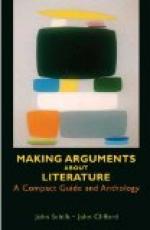53. The Conclusion. The conclusion of your argument should be short and pointed. Gather the main issues together, and restate them in terms that will be easy to remember. Mere repetition of the points as you made them in your introduction may sound too much like lack of resource; on the other hand, it helps to make your points familiar, and to drive them home. In any event make your contentions easy to remember. Most of us go a long way towards settling our own minds on a puzzling question when we repeat to some one else arguments that we have read or heard. If you can so sum up your argument that your readers will go off and unconsciously retail your points to their neighbors, you probably have them. On the other hand, when you have finished your argument, if you start in to hedge and modify and go back to points that have not had enough emphasis before, you throw away all you have gained. In arguing nothing succeeds like decision and certainty of utterance. Even dogmatism is better than an appearance of wabbling. It is the men like Macaulay, who see everything black and white with no shades between, who are the leaders of the world’s opinion. Sum up, then, wherever it is decent to do so, as if there were only one side of the case, and that could be stated in three lines.
54. The Power of Convincing. The convincing power of an argument depends on its appeal to the reason of its readers. To put the same fact in another way, an argument has convincing power when it can fit the facts which it deals with smoothly and intelligently into the rest of the reader’s experience. If an argument on a complicated mass of facts, such as the evidence in a long murder case, makes the reader say, “Yes, now I see how it all happened,” or an argument for the direct election of United States senators makes him say, “Yes, that is a plain working out of the fundamental principles of popular government,” then he is convinced. In this aspect argument merges into exposition. It is significant that, as has already been noted, Matthew Arnold’s argument that Wordsworth is the greatest English poet after Shakespeare and Milton, and Huxley’s argument that the physical basis of animal and plant life is the same, are both used in a book of examples of exposition.[58] The essential difference between argument and exposition from this point of view lies in the emphasis: normally an explanation covers the whole case evenly; an argument throws certain parts and aspects of the case into relief.
If, therefore, to be convincing, your argument must provide a reasonable explanation of the whole state of affairs to which the case belongs, you can use all the devices there are for clear and effective explanation. I will therefore briefly review a few of these.
Of the value of an introduction which lays out the ground to be covered I have already spoken. The more distinct an idea you can implant in your readers’ minds of the course you are going to follow in your argument, the more likely they will be to follow it. Since the success of your argument hangs on carrying them with you on the main issues, let them know beforehand just what those issues are, and in such a way that they can hold them with a minimum of effort. The value of a clear and, as it were, maplike introduction is even greater in an argument than in an exposition.




